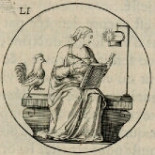Ex libris Georges Ascoli
Earlier this year, I was following via the Internet a book auction held in Génicourt, a village northwest of Paris. Having bid successfully on a … Continue reading
Succession in Barneville
At the beginning of Madame d’Aulnoy’s fairy tale “The White Cat,” an aging and timorous king sets up a winner-take-all competition between his sons: “whichever … Continue reading
The first German translation of Les Contes des fées
A longstanding scholarly consensus holds that German translations of Madame d’Aulnoy’s fairy tales did not appear until the second half of the eighteenth century, starting … Continue reading
Pierre-Daniel Huet in New York
This year should not go by without a brief salute to Pierre-Daniel Huet (1630-1721), the Norman polymath who was one of the most brilliant and … Continue reading
Madame d’Aulnoy and Monsieur le Premier
As biographers have occasionally pointed out, Madame d’Aulnoy was related on the maternal side to one of the most prominent families at the French royal … Continue reading
Baroness or Countess d’Aulnoy?
Among the many mysteries surrounding the life and works of Madame d’Aulnoy is the question of her title of nobility: was she a baroness or … Continue reading
Sentiments of a penitent soul
Laidronnette, the noble but ugly heroine of Madame d’Aulnoy’s fairy tale “Serpentin vert,” begs her royal parents to “allow her to go and shut herself … Continue reading
Anne Le Fèvre Dacier in America
The summer of 1720 in France brought not only an outbreak of bubonic plague in Marseille and the economically disastrous bursting of John Law’s Mississippi … Continue reading
Madame d’Aulnoy’s productive confinement
According to many critics today, Madame d’Aulnoy’s contes des fées originated in the sociable setting of her salon. Jack Zipes, the doyen of American fairy-tale … Continue reading
The autograph and its double
As Voltaire once remarked (or was it Winston Churchill?), forgery surely is the world’s second-oldest profession. This universal truth is confirmed by the history of … Continue reading
The birth and beginnings of Madame d’Aulnoy
Marie-Catherine Le Jumel de Barneville, baronne d’Aulnoy, died in Paris on January 13, 1705 – this has been known for a long time. But when … Continue reading
More Madame d’Aulnoy
Six months ago this blog presented the very rare first edition of Marie-Catherine d’Aulnoy’s Les Contes des fées, of which a complete set (including engraved … Continue reading
Barnett redivivus
In the spring of 2001, while surveying the scholarship on the mysterious Lettres portugaises, I encountered an annoying bibliographical redundancy: a seemingly new article by … Continue reading
Les Contes des fées
The term “fairy tale” originated in 1697, when Marie-Catherine Le Jumel de Barneville, baronne d’Aulnoy, gave the title Les Contes des fées to her first … Continue reading
Bussy-Rabutin’s Book of Hours
On July 1, 1909, Edouard Rahir, the Paris bookseller and bibliographer, visited John Pierpont Morgan, the New York banker and collector, at his London residence … Continue reading
Marie-Madeleine Perrault (1674-1701)
This is no fairy tale but a true story. It is based on archival sources that have lain dormant for centuries and, to my knowledge, … Continue reading
Rubens and the King of France
This summer, the Prado Museum in Madrid hosted the exhibition Tesoros de la Hispanic Society of America: Visiones del mundo hispánico. Among the 200 objects … Continue reading
Only in Lyon
Later this month, the North American Society for Seventeenth-Century French Literature (NASSCFL) will gather in Lyon for its 47th annual conference, devoted to the theme Literature, … Continue reading
Ex bibliotheca R. Toinet
Raymond Toinet (1843-1936) was a lawyer from the town of Tulle in central France. In 1880, he was one among several hundred Catholic magistrates who … Continue reading
Saving Madame de Graffigny
2016 saw the successful completion of a 40-year project: the publication of the Correspondance of Françoise de Graffigny (1695-1758), famous in her time – and … Continue reading
A letter from Racine to Boileau
Many American libraries along the eastern seaboard, from Maine to Washington D.C. and beyond, preserve outstanding autograph collections whose riches remain to be fully explored. … Continue reading
In effigiem Caroli Patin
Claude Lefebvre (1632-1675) was his generation’s leading portrait painter, perhaps best known today for the portrait of Jean-Baptiste Colbert that he presented as his reception … Continue reading






















